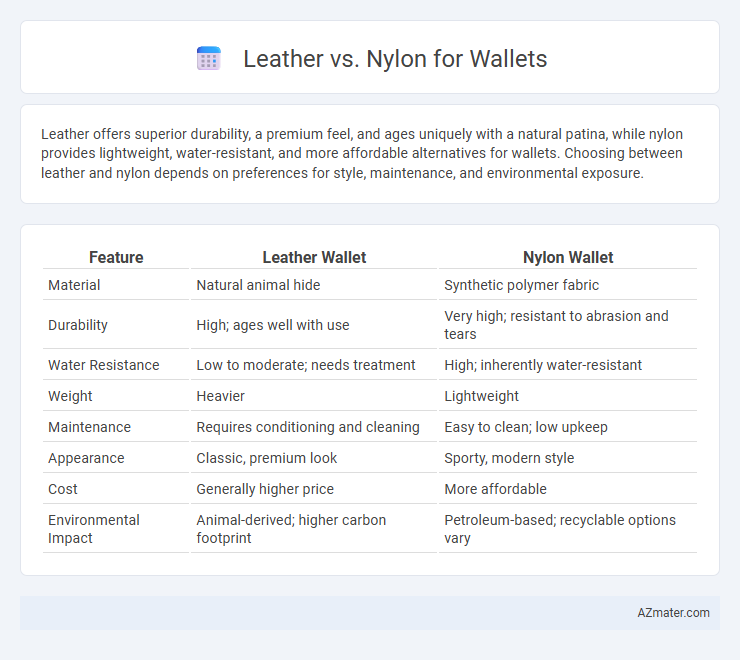Leather offers superior durability, a premium feel, and ages uniquely with a natural patina, while nylon provides lightweight, water-resistant, and more affordable alternatives for wallets. Choosing between leather and nylon depends on preferences for style, maintenance, and environmental exposure.
Table of Comparison
| Feature | Leather Wallet | Nylon Wallet |
|---|---|---|
| Material | Natural animal hide | Synthetic polymer fabric |
| Durability | High; ages well with use | Very high; resistant to abrasion and tears |
| Water Resistance | Low to moderate; needs treatment | High; inherently water-resistant |
| Weight | Heavier | Lightweight |
| Maintenance | Requires conditioning and cleaning | Easy to clean; low upkeep |
| Appearance | Classic, premium look | Sporty, modern style |
| Cost | Generally higher price | More affordable |
| Environmental Impact | Animal-derived; higher carbon footprint | Petroleum-based; recyclable options vary |
Introduction: Leather vs Nylon Wallets
Leather wallets offer a classic, durable option known for aging gracefully and developing a unique patina over time, making them a favorite for those valuing tradition and style. Nylon wallets provide a lightweight, water-resistant alternative that excels in durability and easy maintenance, ideal for active lifestyles and outdoor use. Choosing between leather and nylon depends on preferences for aesthetics, functionality, and everyday wear resistance.
Material Composition and Characteristics
Leather wallets are crafted from animal hides, primarily cowhide, known for their durability, natural texture, and ability to develop a unique patina over time. Nylon wallets use synthetic polymers such as polyamide, offering lightweight, water-resistant, and tear-resistant properties ideal for active lifestyles. The choice between leather's classic, breathable material and nylon's modern, high-performance fabric depends on preferences for tactile feel, maintenance, and environmental resistance.
Durability and Longevity
Leather wallets, crafted from natural animal hides, offer exceptional durability due to their thick, flexible fibers that resist wear and tear over time. Nylon wallets, made from synthetic polymers, provide high resistance to abrasion, water, and stains, making them ideal for harsh environments but potentially less durable under prolonged heavy use compared to premium leather. The longevity of leather wallets often improves with proper care, developing a unique patina, while nylon wallets maintain their original appearance but may suffer from fraying or weakening of fabric fibers after extended exposure to UV light and abrasive conditions.
Style and Aesthetics
Leather wallets exhibit a timeless, sophisticated style with a rich texture and natural patina that enhances over time, making them a popular choice for classic aesthetics. Nylon wallets offer a modern, sleek appearance with vibrant colors and durable, lightweight material that appeals to a contemporary and sporty look. The choice between leather and nylon ultimately depends on whether you prefer traditional elegance or a more casual, versatile style.
Weight and Portability
Leather wallets typically weigh more due to the density and thickness of genuine leather, adding a substantial feel that some users associate with durability and luxury. Nylon wallets offer lightweight portability, often weighing significantly less, making them ideal for minimalist users or those prioritizing ease of carrying. The choice impacts daily convenience, with nylon excelling in compactness and moisture resistance, while leather provides a sturdier, heavier option.
Maintenance and Care
Leather wallets require regular conditioning with specialized leather care products to maintain suppleness, prevent cracking, and protect against moisture damage. Nylon wallets are typically low maintenance, requiring only occasional cleaning with mild soap and water to remove dirt and stains without compromising fabric integrity. Choosing between leather and nylon depends on the desired durability and the time invested in upkeep.
Environmental Impact
Leather wallets typically have a higher environmental impact due to the intensive water usage, greenhouse gas emissions, and chemical treatments involved in cattle farming and leather tanning processes. Nylon wallets, made from synthetic polymers, contribute to microplastic pollution and rely on fossil fuels for production but require less water and land compared to leather. Choosing an eco-friendly wallet involves weighing the carbon footprint of leather against the persistence of nylon pollution in marine ecosystems.
Price Comparison
Leather wallets typically cost between $30 and $150 depending on the brand and quality of the hide, with premium full-grain leather options commanding even higher prices. Nylon wallets are generally more affordable, often available from $10 to $50, making them a budget-friendly choice without sacrificing durability. The price difference reflects leather's luxury appeal and longevity versus nylon's lightweight, functional design favored for casual or outdoor use.
User Experience and Comfort
Leather wallets offer a soft, supple texture that molds to the user's hand over time, providing a luxurious and comfortable grip. Nylon wallets are lightweight, water-resistant, and flexible, making them ideal for active users who prioritize durability and ease of maintenance. Both materials impact comfort differently: leather enhances tactile satisfaction, while nylon ensures practicality and resilience in everyday use.
Which Wallet Material is Right for You?
Leather wallets offer durability, a classic look, and develop a unique patina over time, making them ideal for those who value style and longevity. Nylon wallets provide lightweight, water-resistant, and budget-friendly alternatives suited for active lifestyles and frequent travelers. Choosing between leather and nylon depends on preferences for aesthetics, maintenance, and practicality.

Infographic: Leather vs Nylon for Wallet
 azmater.com
azmater.com